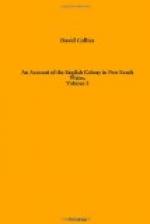Having been favoured with a more minute and ornithological description of the elegant and novel bird mentioned in page 65* of the preceding sheets since they were sent to the press, it is here given.
[* . . . They brought in with them one of the birds which they had named pheasants, but which on examination appeared to be a variety of the Bird of Paradise.]
The bill of this bird, which has been named the Maenura superba, is straight, having the nostrils in the centre of the beak. The base of the upper mandible is furnished with hairs like feathers turning down; the upper mandible is at the base somewhat like that of the pigeon. The eye is a dark hazel, with a bare space around it. The throat and chin are of a dark rufous colour: the rest, with the body, of a dusky grey. The feathers on the rump are longer than those of the body, and more divided. The colour of the wings, which are concave, is dark rufous. The legs and claws are large in proportion to the bird, particularly the claws. The outward toe is connected with the middle one as far as the first joint. The tail is long, and composed of three different sorts of feathers, of which the upper side is of a dark grey, with ferruginous spots. The first two lower feathers, which are a little curved, in two directions, are beneath of a pearly colour, enriched with several crescent shaped spaces, of a rich rufous and black colour. The laminae are unwebbed, turned round toward the extremity, and ornamented with a black bar, the breadth of an inch, and fringed at the end. The shaft of the second, which is likewise long, is fringed with long hair-like filaments; and the third, which is also long and curved, is plumed on the inner side only, except at the extremity, where there are a few separated filaments of a dark grey colour.
The female Maenura superba differs very little from the male, except in the tail, which is composed of twelve feathers a little curved and plumed, having the upper side dark rufous and grey, and the under of a pearly colour.
The following curious particulars of these birds were observed by persons resident in the country, and who were eye-witnesses of what is here told.
They frequent retired and inaccessible parts of the interior; have been seen to run remarkably fast, but their tails are so cumbrous that they cannot fly in a direct line. They sing for two hours in the morning, beginning from the time when they quit the valley, until they attain the summit of the hill; where they scrape together a small hillock, on which they stand, with their tall spread over them, imitating successively the note of every bird known in the country. They then return to the valley.
The drawing from which the engraving is made was taken from a beautiful stuffed Maenura superba in the collection of Mr. Arthur Harrison (who also is in possession of a female Maenura superba), and which was presented to that gentleman by Governor Hunter.




